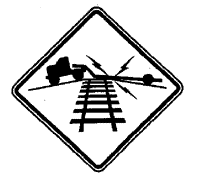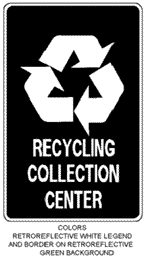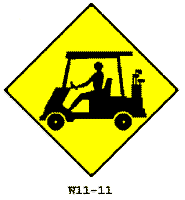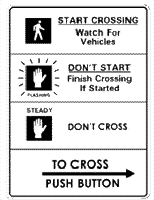
Request I-10(C)--Standardization of Traffic Control Devices on Private Property.
Revise Section 1A-3 by adding a new paragraph 3 as follows:
Additionally, States are encouraged to adopt Uniform Vehicle Code, Section 15-117 which states that, "No person shall install or maintain in any area of private property used by the public any sign, signal, marking or other device intended to regulate, warn or guide traffic unless it conforms with the State manual and specifications adopted under ' 15-104."
Revise the last paragraph in Section 1A-3 to read:
Under authority granted by Congress in 1966, the Secretary of Transportation has decreed that traffic control devices on all streets and highways open to public travel in each State shall be in substantial conformance with standards issued or endorsed by the Federal Highway Administrator.
Request II-118(C)--Standard Motorcycle Warning Sign
Revise the first paragraph of Section 2C-40 by inserting a new sentence between the current first and second sentence to read as follows:
States and local highway agencies may develop word message signs to warn roadway users of special situations or hazards such as AMotorcylcist Watch for Grooved Pavements Ahead.@
Request II-120(C)--Standard Warning Signs for Substandard Vertical Curves Over Railroad Crossings
(W10-5)
Add the following new section:
8B-11 Low Ground Clearance Crossings (W10-5)
Rail-highway grade crossings with a sharp rise or depression in the profile
of the road near the rails may require additional signing. Whenever conditions
are sufficiently abrupt to create a hang-up of long wheelbase vehicles or trailers
with low ground clearance, the ALow Ground Clearance@ (W10-5) warning symbol
sign shall be installed in advance of the crossing. New warning symbol signs
such as this which may not be readily recognizable by the public, shall be accompanied
by an educational plaque which is to remain in place for at least 3 years after
initial installation (see section 2A-13). The appropriate color of this sign
is yellow background with black symbol and border. A supplemental message such
as AAhead,@ ANext Crossing,@ or AUse Next Crossing@ (with appropriate arrows)
should be placed at the nearest intersecting road where a vehicle can detour
or at a point on the roadway wide enough to permit a U-Turn.
There are some rail-highway grade crossings where engineering investigation of roadway geometric and operating conditions confirm that vehicle speeds across the railroad tracks should be at least 10 mph below the posted speed limit. To insure that the vehicle driver does not lose control while using the crossing, word message signs such as ABump,@ ADip,@ or ARough Crossing@ with an advisory speed plate is an appropriate installation treatment. Information on railroad ground clearance requirements is also available in the American Railway Engineering Association Section 8.1.2 or the American Association of State Highway and Transportation Official=s Policy on Geometric Design of Highways and Streets.
Request II-138(C)--Stop Sign Placement
Revise the last paragraph of Section 2A-21 to read as follows:
Standard positions for a number of typical signs are illustrated in figures 2-1 to 2-4. These typical drawings provide recommended practice for the design, application, and installation of traffic control device unless an engineering study by a State or local highway agency determines otherwise.
Request II-193(C)--Number of Logos Permitted on Specific Service Signs
Revise Section 2G-5.2, paragraph 1 to read:
A business LOGO can be either a business identification symbol/trademark or a word message. The business LOGO shall be shown on a separate panel which is attached to the specific service sign. If the business LOGO is a word message, then it should have a blue background with a white legend and border. The principle legend should be at least equal in height to the directional legend on the sign. Where business identification symbols or trademarks are used alone for a LOGO, the border may be omitted. The symbol or trademark shall be reproduced in the colors and general shape consistent with customary use, and any integral legend shall be in proportionate size.
 Request
II-194(C)--Recycling Collection Center Sign (I-11)
Request
II-194(C)--Recycling Collection Center Sign (I-11)
Add a new paragraph to Section 2D-48 to read:
The Recycling Collection symbol (I-11) may be used to direct motorists to recycling collection centers. These signs should not be used on freeways and expressways. If used on these facilities, the recycling center sign is considered as one of the supplemental sign destinations.
 Request
II-204(C)--Golf Cart Crossing Symbol
Request
II-204(C)--Golf Cart Crossing Symbol
On page 2C-17, remove the
Deer Crossing symbol (W11-3) and replace it with the Golf Cart Crossing symbol
(W11-11). The Deer
Crossing symbol is still appropriate for use. However, we feel that since most
people are familiar with the Deer Crossing symbol, we decided to show the Golf
Cart Crossing symbol instead.
Request II-209(C)--Signing for the Disabled
Add the following discussion at the end of Section 2B-31:
Where parking spaces are designated to accommodate wheel-chair vans, the standard R7-8 regulatory sign is to be used along with the word message "Van Accessible." Since the Van Accessible sign supplements the R7-8 sign, it should have a white background with green or black legend. Reverse background and legend colors may be used as an alternate.
The mounting height of the R7-8 sign is 7 feet minimum. The "Van Accessible" sign dimension sizes are 12 x 6 inches (minimum) or 18 x 9 inches (standard) with series D letters. The minimum mounting height will be 6 feet, 6 inches and 6 feet, 3 inches respectively.
Where a guide sign is needed to direct motorists to van-accessible parking facilities, the sign will have white legend on a blue background with an appropriate directional arrow. Both the regulatory and directional "Van Accessible" sign are retroreflective.
Request II-211(C)--Non-Carrier Airport Symbol
Add the following discussion as a 3rd paragraph to section 2D-48:
Guide signs for commercial service airports and non-carrier airports may be provided from the nearest Interstate, other freeway, or conventional highway intersection directly to the airport, normally not to exceed 15 miles. The airport symbol sign (I-5) along with a supplemental plaque may be used to indicate the specific name of the airport. Adequate trailblazer signs must be inplace prior to installing these guide signs. Location and placement of all airport guide signing is dependent upon the availability of longitudinal spacing on highways. An airport symbol sign with or without a supplemental name plaque or the word "AIRPORT" and an arrow, may be used as a trailblazer. Airport guide signs must be fully retroreflectorized with a white legend on a green background.
Request II-212(C)--Increased Letter Size of Street Name Signs
Revise Section 2D-39, paragraph 2 to read:
Lettering on street name signs should be at least 6 inches high. If uppercase and lowercase letters are used, then the uppercase letters would be 6 inches with 4-1/2 inch lower case letters. Abbreviated lettering to indicate the type of street or section of city (e.g., Ave., N.W., etc.) may be in smaller lettering, at least 3 inches high. However, for local roads with speed limits 25 mph or less, the lettering may be a minimum of 4 inches with 2 inch letters for street abreviations or city sections.
Revise the first sentence of paragraph 4 of this same section to read:
The Street Name sign shall be retroreflectorized.
Request II-215(C)--Regulatory and Street Name Signs on Same Post
Add the following discussion at the end of Section 2B-4:
As an alternate application, the street name sign may be placed above a STOP sign, with no required vertical separation.
Add the following discussion at the end of the first paragraph of Section 2D-39:
As an alternate application, the street name sign may be placed above a regulatory sign, with no required vertical separation.
Request II-218(C)--Standard Motorcycle Warning Sign
Revise the first paragraph of Section 2C-40 by inserting a new sentence between the current first and second sentence to read as follows:
States and local highway agencies may develop word message signs to warn roadway users of special situations or hazards such as AMotorcyclist Watch for Grooved Pavements Ahead.@
Request II-224(C)--Cellular Phone Signing for Emergency Situations
Revise the eighth paragraph of Section 2D-45 to include the following sentence:
An AEmergency Dial---@ sign (D12-4) along with the appropriate number to dial may be used for cellular phone information.
Request II-225(C)--Local Transit Logo and Carpool Symbol
Revise the second sentence of paragraph 2 of Section 2D-41 to read:
The maximum vertical dimension of the local transit logo and/or carpool symbol is 36 inches.
Request II-226(C)--General Motorist Service Signing for Alternative
Fuels
Add the following to the last sentence of paragraph 2 in Section 2D-45 to read:
Individual States may sign for whatever alternative fuels are available at appropriate locations.
Add the following alternative fuel designations to item 1 of paragraph 3 of Section 2F-33 to read:
1. Gas, Diesel, LP-Gas, CNG, EV-Charging and any other alternative fuels.
 Request
II-228(C)--Share the Road Warning Sign (W16-1)
Request
II-228(C)--Share the Road Warning Sign (W16-1)
Add a new section 2C-39 entitled, AShare the Road Sign@ and include the following language:
In situations where there is a need to warn motorist to watch for other slower forms of transportation traveling along the highway such as bicycles, golf carts, farm machinery, etc., the Share the Road word message sign (W16-1) may be used.
Renumber the remaining sections (Playground Sign and Other Warning Signs) accordingly.
Request II-229(C)--General Service Sign for Truck Parking
In section 2D-45, add Truck Parking to the list of general services described in the first sentence of paragraph 3. Revise the remainder of this paragraph to read as follows:
The service legends may be either symbols or word messages except for the Truck Parking sign (D9-15) which shall be a word message. The intermixing of symbols and word messages on one sign panel shall not be permitted. The word message ATruck Parking@ should be placed on a separate panel below the other general motorist services. Formats for displaying different combinations of these services are presented in section 2F-33.
In section 2F-33, after the next to last paragraph, add the following paragraph:
A ATruck Parking@ word message sign (D9-15) may be used on a separate panel below the other general motorist services to direct truck drivers to designated parking areas.
Request II-246(C)--Adopt-A-Highway Signs
Revise section 2D-48, General Information Signs, by inserting the following between the first and second paragraph:
Adopt-A-Highway signs provide travelers with information about organizations that take responsibility for picking up litter along a section of highway. Messages, symbols, and trademark which resemble any official traffic control device shall not be used.
Each agency with highway jurisdiction that elects to use Adopt-A-Highway signs should establish a signing policy which includes the following:
1. Eligible organizations shall comply with State laws without regard to race, religion, color, age, sex, or national origin, and laws concerning the licensing and approval of service facilities.
2. The use of legends conforming to the requirements of State agencies.
3. Removal of inappropriate signs.
4. Provision for States to charge fees to cover the cost of signing through a permit system. Determination of the cots to businesses for initial permits, installations, annual maintenance, removal, etc., of the signs.
5. Standard highway alphabets shall be used on all word message type signs.
6. Provision for limiting the number of signs.
Request III-68(C)--Lane Drop Marking Pattern
Page 3A-2, Section 3A-5, revise number 4 to read, "Broken and dotted lines are permissive in character."
Page 3A-2, Section 3A-6, add the following:
6. The lane drop marking pattern consists of 8-inch wide by 3-foot long white stripes separated by 12-foot gaps.
Page 3A-4, add the following to number 8: "The dotted line may be used as a special guide line to direct through-traffic from entering a mandatory left turn lane or bay. The dotted line when used in this case does not necessarily have to be the extension of an existing line, or the same color as the intersecting line where the dotted line starts. (See figure)"
Page 3B-14, Section 3B-11, paragraph 4, revise the 2nd and 3rd sentence to read, "A typical lane drop marking consists of 8-inch by 3-foot long white stripes separated by 12-foot gaps. If used, this lane drop marking should begin 2 mile in advance of the theoretical gore point.
Page 3B-15, Figure 3-11a, substitute the word "broken" for the word "dashed."
Request IV-47(C)--Use of Steady and Flashing Downward Yellow Arrows in Lane Control Signals.
Revise the last paragraph of Section 4E-12 to read:
When used, lane-use signals shall be operated continuously. When used for reversible lane operation or for left turn lane operation, lane use control signals shall be operated continuously. When used for nonreversible freeway lane operation, continuous operation of lane use control signals is not required.
Request IV-95(C)--Intersection Control Beacons.
Revise the wording of the fourth paragraph of Section 4E-3 as follows:
A stop sign should shall be used with a flashing red Intersection Control Beacon.
Request IV-118(C)--Relocate Section 4C, Signal Warrants
Rename existing Section 4B from TRAFFIC CONTROL SIGNALS to WARRANTS and rename existing Section 4C from WARRANTS to TRAFFIC CONTROL SIGNALS.
Request IV-122(C)--Disabled Pedestrians.
Add the following paragraph after the first paragraph to section 4B-29, Pedestrian Detectors:
Pedestrian detectors (push buttons) should be easily activated and conveniently located near each end of crosswalks where pedestrian actuation is required.
 R10-3b 225 mm x 300 mm (9" x 12") |
Request IV-124(C)--Educational Plaque for Pedestrian Signals.
Add the following wording to the end of the third paragraph of Section 2B-37, Traffic Signal Signs:
Where symbol-type pedestrian
signal indications are used, an educational plaque (R10-3b) may be used to improve
pedestrian understanding of pedestrian indications at signalized
intersections.
Request VI-88(C)--Emergency Flashers
Revise the Section 6F-7c, paragraph five by inserting as the new second sentence, "As a supplement to a rotating dome or strobe light, vehicular hazard warning signals may be used when a vehicle is stopped on or adjacent to a roadway.@
Request VIII-26(C)--Maximum Flash Rate at Railroad highway Grade Crossings
Revise 8C-7, third paragraph, second sentence, by changing the number 55 to 65 before the word maximum.
Request IX-6(C)--Marking Hazardous Bicycle Conditions.
Revise the Section Title to "Object Markers." Also, replace the first sentence of paragraph 1 with the following two sentences:
There may be roadway situations where a drain, grate or other roadway condition may be hazardous to the bicyclist. If visible to the rider, the hazardous condition may be avoided with little difficulty.